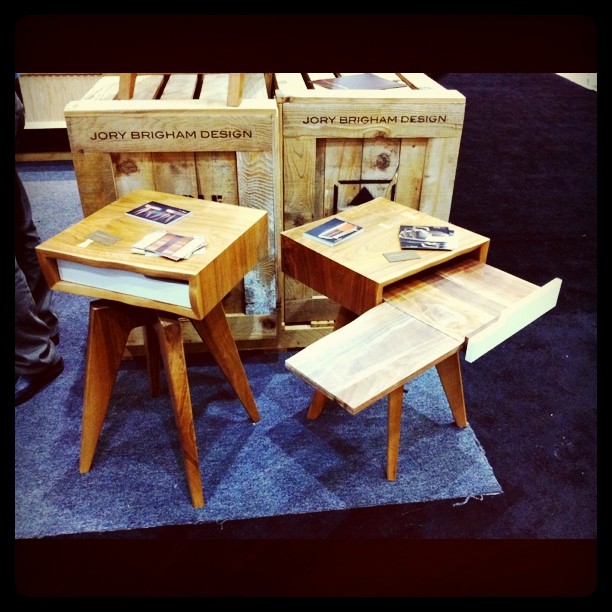By Peter Levelle
Last month, I had a chance to visit the Dwell on Design tradeshow at the LA Convention Center. It was impressive to see the range of products, all the way from coffee makers to a full pre-fab house that was going to be  auctioned off on ebay. Even Airstream had a trailer there (is that white leather?). I was surprised and inspired to see the number of small-shop design-oriented fabricators, including two chicken coops with live chickens. The hen houses were designed to teach kids about the incubation process of a chicken egg, but also works great for inner city dwellers with small yards.
auctioned off on ebay. Even Airstream had a trailer there (is that white leather?). I was surprised and inspired to see the number of small-shop design-oriented fabricators, including two chicken coops with live chickens. The hen houses were designed to teach kids about the incubation process of a chicken egg, but also works great for inner city dwellers with small yards.
The highlight of the evening was the rather impressive lectures and discussion panels. Eric Owen Moss described why he feels architecture needs an enemy and the challenges to future designers. “Interesting architecture comes from an essential dissatisfaction.” Avant-garde modern architecture was challenged by a very visible and reluctant society in its heyday, and as a result produced some very interesting work. How does this apply to our architecture of today? In addition, Moss reflected on how the challenge to the next generation of designers is going to be the large scale of projects. Some recent examples include moving the Yellow River in China, or a proposal to re-introduce the Mississippi Delta, an area the size of a small state.
Other interesting talks included a panel on prefab houses with Method Homes and Proto Homes (two of the leading prefab firms), a talk with Craig Steely, a showing of some original Charles and Ray Eames produced movies, and the Dwell on Design Modern World Awards for not only restaurants but product design as well.

Photos by Evan Troxel
The night concluded with the keynote speaker, William McDonough, author of Cradle-to-Cradle, a leader in sustainability and an early practitioner. You may recall his design of the Gap Headquarters in South San Francisco with its Green Roof, built before LEED points even existed. As a child, McDonough grew up in Japan and witnessed firsthand the destruction of Hiroshima and Nagasaki, and this led to a personal quest to create a better world for future generations. McDonough challenged contemporary views on sustainability. In his view, the current system has done a good job of raising awareness, but falls short of its ultimate goal. To paraphrase McDonough, it is the designer’s responsibility to extend his sustainability goals from decades to eons. What will this building look like in 500 years? Will the materials disassemble easily and readily return to raw materials? Does the building give back to the community in the form of tangible goods? The Gap Building was designed to become housing in later generations. A chair McDonough designed for Herman Miller disassembles into its base components that are easily recycled or returned to raw materials. His rural residential projects typically are constructed of materials which if disassembled can decompose in the forest in which the they sit. Larger commercial and industrial projects take it a step further, and typically function not only as space, but a generator, growing food or spawning a natural habitat long since removed from the concrete jungle.
 Overall, Dwell on Design was an inspiring and diverse show to attend. I was surprised by the range and diversity of products, form large companies to small custom fabrication shops. I even had a chance to meet Sam Lubbell, editor of the West Coast version of the Architect’s Newspaper, a great source for local current events within the design world. I recognized him from a talk he hosted earlier this year on prefab design, something I posted about earlier here.
Overall, Dwell on Design was an inspiring and diverse show to attend. I was surprised by the range and diversity of products, form large companies to small custom fabrication shops. I even had a chance to meet Sam Lubbell, editor of the West Coast version of the Architect’s Newspaper, a great source for local current events within the design world. I recognized him from a talk he hosted earlier this year on prefab design, something I posted about earlier here.
Below are some links to some of the more interesting products and designers I encountered at the show.
